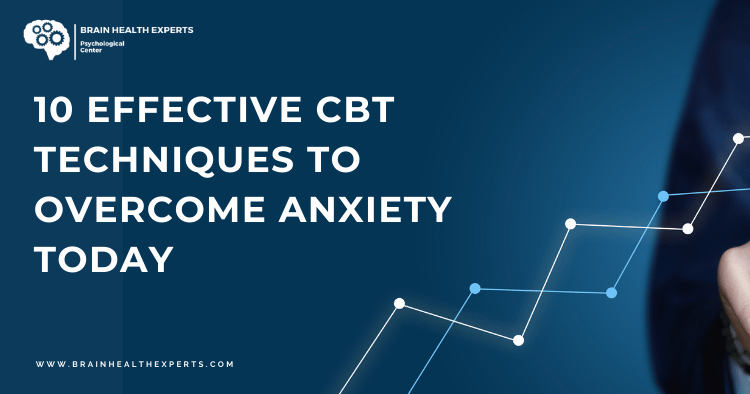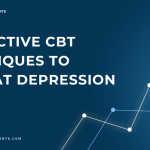Table of Contents
- Introduction
- Understanding Anxiety and CBT
- 1. Cognitive Restructuring
- 2. Behavioral Activation
- 3. Exposure Therapy
- 4. Mindfulness and Relaxation Techniques
- 5. Journaling
- 6. Thought Records
- 7. Socratic Questioning
- 8. Problem-Solving Skills
- 9. Activity Scheduling
- 10. Self-Monitoring
- FAQs
- Conclusion
Introduction
Anxiety can feel overwhelming, affecting your daily life and overall well-being. Fortunately, Cognitive Behavioral Therapy (CBT) offers practical techniques to help manage and reduce anxiety. In this article, we’ll explore 10 effective CBT techniques that you can start using today to reclaim your peace of mind.
Understanding Anxiety and CBT
Anxiety is a natural response to stress, but it can become problematic when it interferes with daily functioning. CBT is a structured, time-limited therapeutic approach that addresses negative thought patterns and behaviors contributing to anxiety. Research indicates that CBT is effective in treating various anxiety disorders, making it a go-to method for mental health professionals.
Why Choose CBT for Anxiety?
- Evidence-Based: CBT is backed by extensive research and has a high success rate.
- Skills-Oriented: It provides practical tools and techniques you can apply in real life.
- Empowering: CBT helps individuals take control of their thoughts and behaviors.
1. Cognitive Restructuring
Cognitive restructuring involves identifying and challenging negative thoughts that contribute to anxiety.
How It Works:
- Identify Negative Thoughts: Notice when anxiety-provoking thoughts arise.
- Challenge These Thoughts: Ask yourself if they are rational. For example, if you think, “I’ll embarrass myself in the meeting,” consider evidence for and against this thought.
- Replace with Positive Thoughts: Formulate a more balanced perspective, such as, “I have prepared well, and I can handle this.”
Example:
If you fear flying, instead of thinking, “The plane will crash,” challenge it with facts about aviation safety.
2. Behavioral Activation
Behavioral activation encourages individuals to engage in activities that bring joy, helping to combat anxiety.
Steps to Implement:
- Identify Enjoyable Activities: List things you enjoy, like reading or walking.
- Schedule These Activities: Set aside time each week to engage in these activities.
- Reflect on Your Feelings: After engaging, note how you feel to reinforce the positive impact.
3. Exposure Therapy
Exposure therapy involves gradual exposure to anxiety-provoking situations to reduce fear over time.
How It Works:
- Create a Fear Hierarchy: List situations that cause anxiety from least to most anxiety-inducing.
- Gradual Exposure: Start with the least fearful situation, gradually working your way up.
- Practice Coping Strategies: Use relaxation techniques during exposure.
Example:
If you’re anxious about social situations, start by saying hello to a neighbor before attending a larger gathering.
4. Mindfulness and Relaxation Techniques
Mindfulness helps you stay present and reduce anxiety. Techniques include deep breathing, progressive muscle relaxation, and meditation.
Techniques to Try:
- Deep Breathing: Inhale deeply for four counts, hold for four, and exhale for four.
- Progressive Muscle Relaxation: Tense and relax each muscle group.
- Guided Meditations: Use apps like Headspace or Calm for structured sessions.
5. Journaling
Journaling can help you process thoughts and emotions associated with anxiety.
How to Journal:
- Daily Reflection: Write about your thoughts and feelings each day.
- Identify Triggers: Note situations that provoke anxiety to identify patterns.
- Gratitude Journaling: List things you are grateful for to shift focus from anxiety.
6. Thought Records
Thought records help you systematically evaluate and challenge negative thoughts.
How to Use:
- Identify the Situation: Write down the event that triggered anxiety.
- Record Thoughts and Feelings: Note what you were thinking and feeling at the time.
- Challenge and Reframe: Analyze the thought and create a more balanced response.
7. Socratic Questioning
Socratic questioning involves asking probing questions to challenge your thoughts and assumptions.
Questions to Consider:
- What is the evidence for this thought?
- Is there an alternative explanation?
- What would I tell a friend in this situation?
8. Problem-Solving Skills
Effective problem-solving can reduce anxiety by helping you feel more in control.
Steps:
- Define the Problem: Clearly state what is causing anxiety.
- Generate Solutions: Brainstorm possible ways to address the issue.
- Evaluate and Choose: Assess the pros and cons of each solution before deciding.
9. Activity Scheduling
Scheduling activities can help structure your time and reduce feelings of overwhelm.
How to Schedule:
- Use a Planner: Plan your week in advance, including work and leisure activities.
- Incorporate Breaks: Make sure to include downtime for relaxation.
- Review and Adjust: At the end of the week, assess what worked and what didn’t.
10. Self-Monitoring
Self-monitoring involves tracking your anxiety levels and responses to different situations.
How to Self-Monitor:
- Keep a Log: Document your anxiety levels, triggers, and coping strategies used.
- Reflect on Patterns: Look for recurring themes in your anxiety to better understand it.
- Adjust Techniques: Change your approach based on what you learn from your log.
FAQs
What is the success rate of CBT for anxiety disorders?
CBT has a success rate of about 60-80% for treating anxiety disorders, depending on the individual and the specific disorder.
How long does CBT take to show results?
While some individuals may see improvements in a few weeks, a typical course of CBT lasts around 12-20 sessions, with noticeable changes often occurring within the first few sessions.
Can I practice CBT techniques on my own?
Yes! Many CBT techniques can be practiced independently, but working with a trained therapist can enhance your understanding and application of these strategies.
Conclusion
Overcoming anxiety is a journey, but utilizing these 10 effective CBT techniques can make a significant difference in managing your symptoms. Whether you choose to journal, practice mindfulness, or engage in exposure therapy, the key is to find what works best for you. Remember, it’s always okay to seek professional help if you need it.
For more resources on CBT and mental health, consider visiting National Institute of Mental Health and American Psychological Association.
By integrating these techniques into your life, you can take proactive steps toward a more peaceful and fulfilling existence. Start today, and watch your anxiety begin to diminish!





